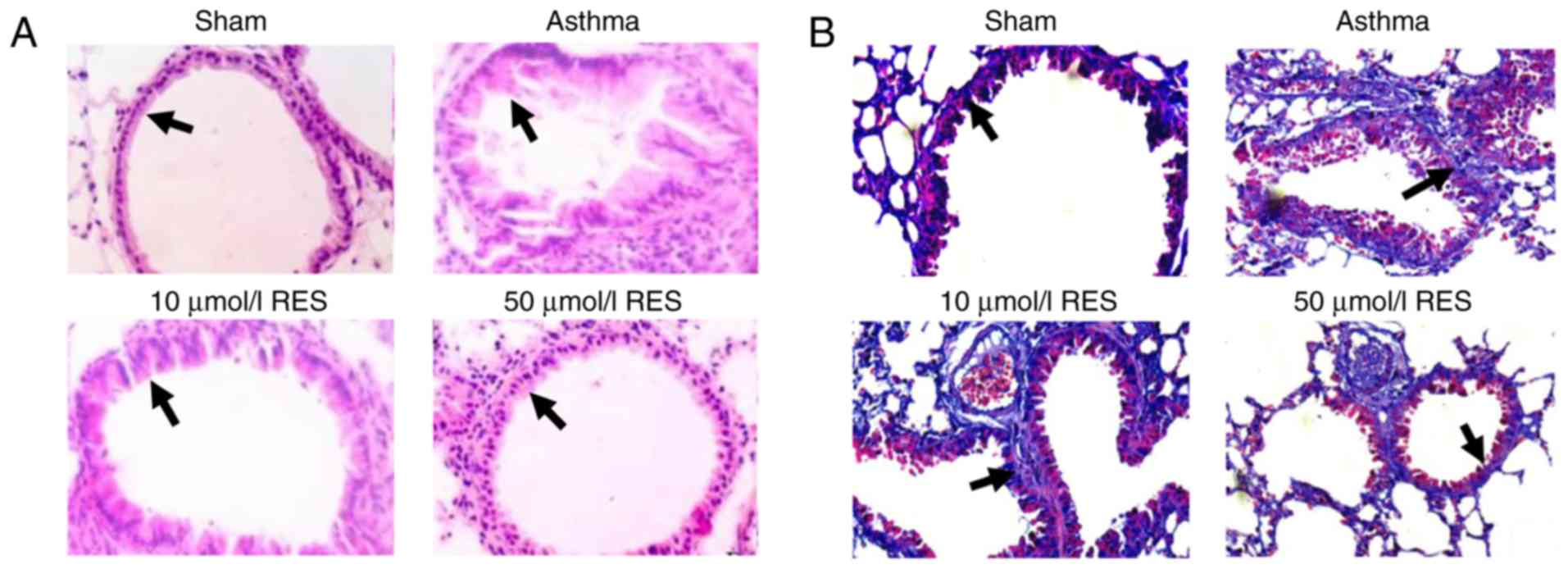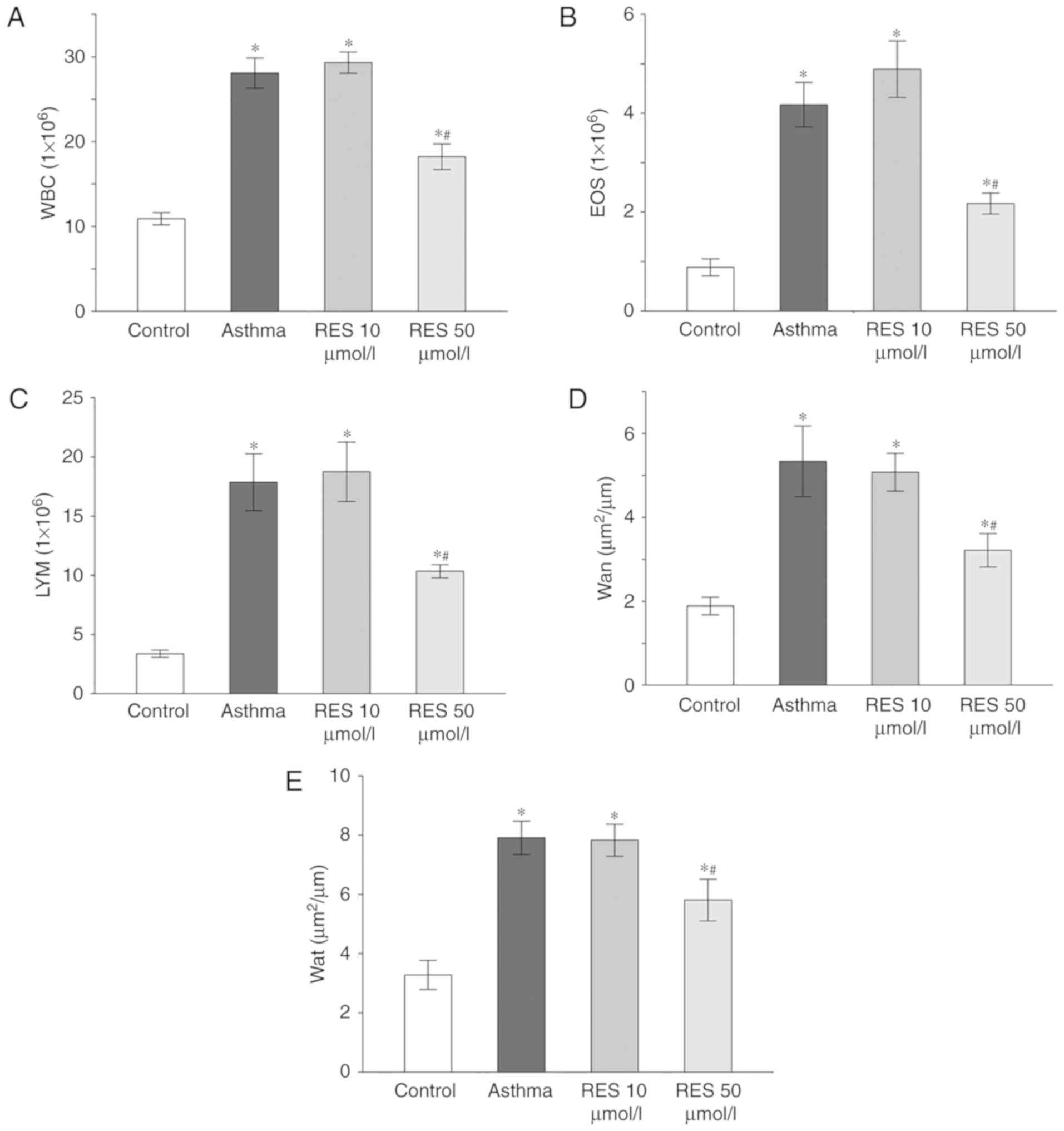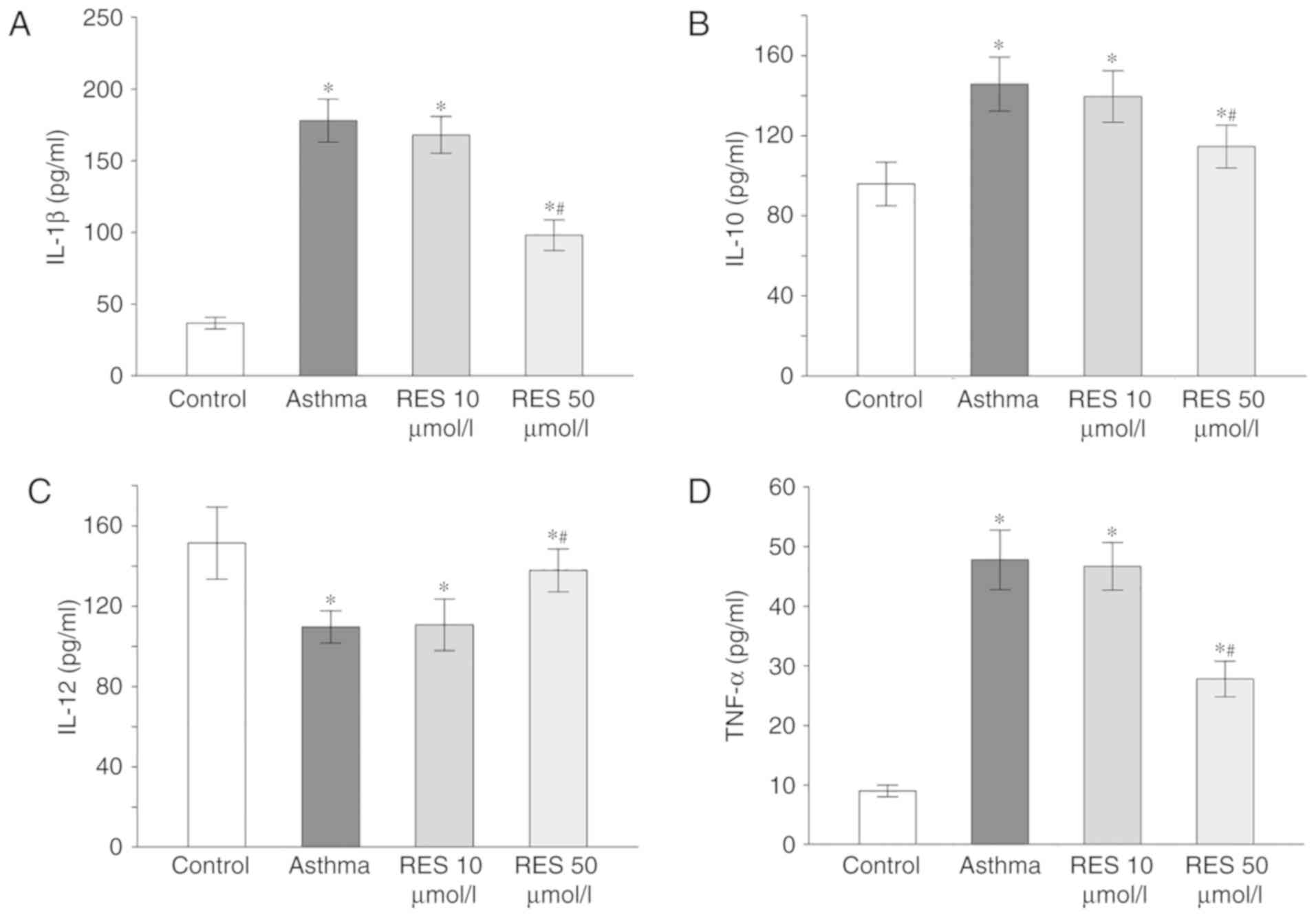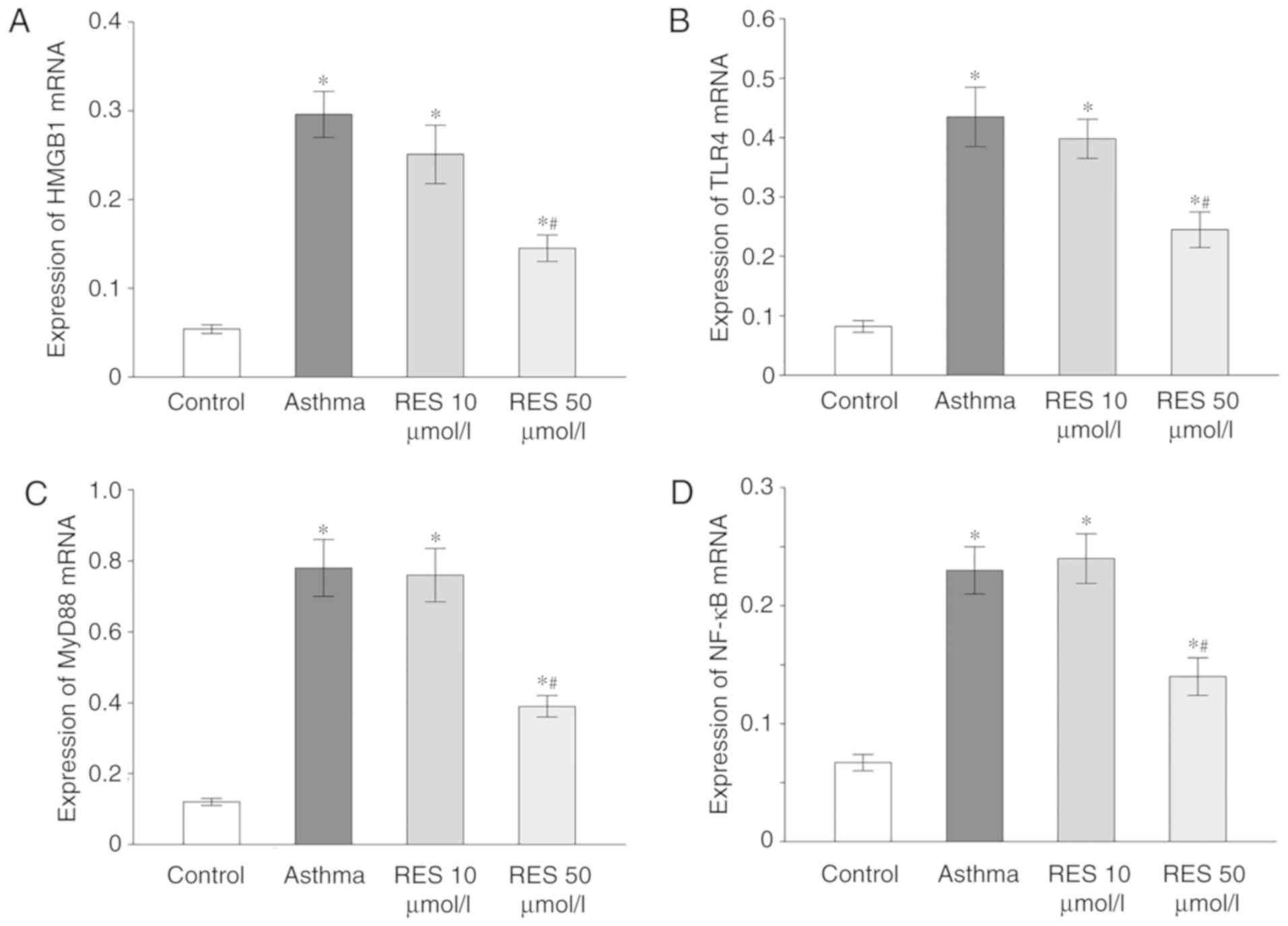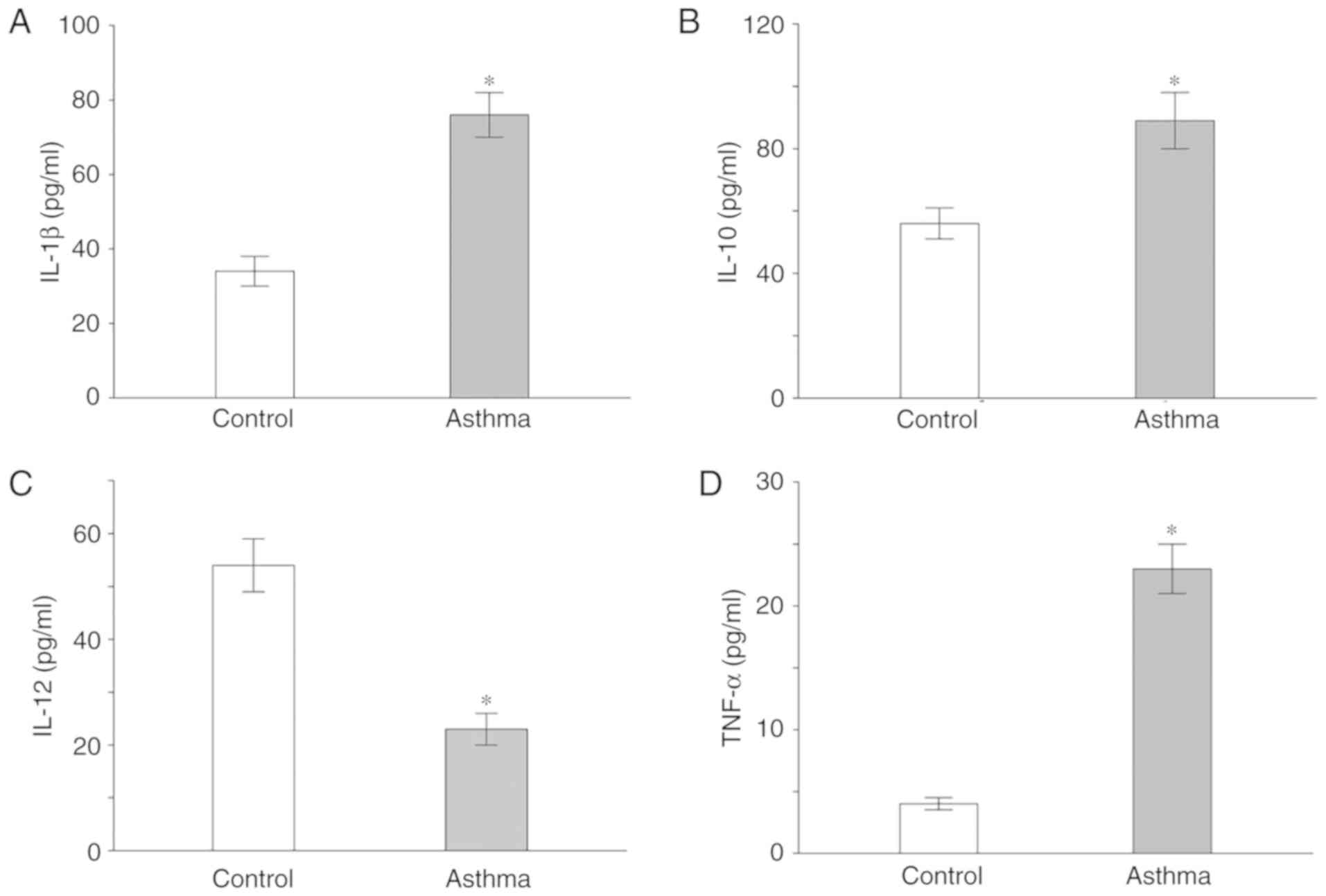|
1
|
Guilbert TW, Mauger DT and Lemanske RF Jr:
Childhood asthma-predictive phenotype. J Allergy Clin Immunol
Pract. 2:664–670. 2014. View Article : Google Scholar : PubMed/NCBI
|
|
2
|
Pinfield J, Gaskin K, Bentley J and Rouse
J: Recognition and management of asthma in children and young
people. Nurs Stand. 30:50–58. 2015. View Article : Google Scholar : PubMed/NCBI
|
|
3
|
Us'Ka VR: Role of psychological factors in
the etiology of asthma in children. Lik Sprava. 148–150. 2015.(In
Ukrainian). PubMed/NCBI
|
|
4
|
Croisant S: Epidemiology of asthma:
Prevalence and burden of disease. Adv Exp Med Biol. 795:17–29.
2014. View Article : Google Scholar : PubMed/NCBI
|
|
5
|
Raedler D and Schaub B: Immune mechanisms
and development of childhood asthma. Lancet Respir Med. 2:647–656.
2014. View Article : Google Scholar : PubMed/NCBI
|
|
6
|
Rosenberg SL, Miller GE, Brehm JM and
Celedon JC: Stress and asthma: Novel insights on genetic,
epigenetic and immunologic mechanisms. J Allergy Clin Immunol.
134:1009–1015. 2014. View Article : Google Scholar : PubMed/NCBI
|
|
7
|
Khan DA: Allergic rhinitis and asthma:
Epidemiology and common pathophysiology. Allergy Asthma Proc.
35:357–361. 2014. View Article : Google Scholar : PubMed/NCBI
|
|
8
|
Yang Q, Liu X, Yao Z, Mao S, Wei Q and
Chang Y: Penehyclidine hydrochloride inhibits the release of
high-mobility group box 1 in lipopolysaccharide-activated RAW264.7
cells and cecal ligation and puncture-induced septic mice. J Surg
Res. 186:310–317. 2014. View Article : Google Scholar : PubMed/NCBI
|
|
9
|
Musumeci D, Roviello GN and Montesarchio
D: An overview on HMGB1 inhibitors as potential therapeutic agents
in HMGB1-related pathologies. Pharmacol Ther. 141:347–357. 2014.
View Article : Google Scholar : PubMed/NCBI
|
|
10
|
Dumitriu IE, Baruah P, Valentinis B, Voll
RE, Herrmann M, Nawroth PP, Arnold B, Bianchi ME, Manfredi AA and
Rovere-Querini P: Release of high mobility group box 1 by dendritic
cells controls T cell activation via the receptor for advanced
glycation end products. J Immunol. 174:7506–7515. 2005. View Article : Google Scholar : PubMed/NCBI
|
|
11
|
Park JS, Svetkauskaite D, He Q, Kim JY,
Strassheim D, Ishizaka A and Abraham E: Involvement of Τoll-like
receptors 2 and 4 in cellular activation by high mobility group box
1 protein. J Biol Chem. 279:7370–7377. 2004. View Article : Google Scholar : PubMed/NCBI
|
|
12
|
Yang H, Hreggvidsdottir HS, Palmblad K,
Wang H, Ochani M, Li J, Lu B, Chavan S, Rosas-Ballina M, Al-Abed Y,
et al: A critical cysteine is required for HMGB1 binding to
Toll-like receptor 4 and activation of macrophage cytokine release.
Proc Natl Acad Sci USA. 107:11942–11947. 2010. View Article : Google Scholar : PubMed/NCBI
|
|
13
|
Andersson U, Wang H, Palmblad K, Aveberger
AC, Bloom O, Erlandsson-Harris H, Janson A, Kokkola R, Zhang M,
Yang H and Tracey KJ: High mobility group 1 protein (HMG-1)
stimulates proinflammatory cytokine synthesis in human monocytes. J
Exp Med. 192:565–570. 2000. View Article : Google Scholar : PubMed/NCBI
|
|
14
|
Park JS, Arcaroli J, Yum HK, Yang H, Wang
H, Yang KY, Choe KH, Strassheim D, Pitts TM, Tracey KJ and Abraham
E: Activation of gene expression in human neutrophils by high
mobility group box 1 protein. Am J Physiol Cell Physiol.
284:C870–C879. 2003. View Article : Google Scholar : PubMed/NCBI
|
|
15
|
Wang J, He F, Chen L, Li Q, Jin S, Zheng
H, Lin J, Zhang H, Ma S, Mei J and Yu J: Resveratrol inhibits
pulmonary fibrosis by regulating miR-21 through MAPK/AP-1 pathways.
Biomed Pharmacother. 105:37–44. 2018. View Article : Google Scholar : PubMed/NCBI
|
|
16
|
Wang XL, Li T, Li JH, Miao SY and Xiao XZ:
The effects of resveratrol on inflammation and oxidative stress in
a rat model of chronic obstructive pulmonary disease. Molecules.
22:E15292017. View Article : Google Scholar : PubMed/NCBI
|
|
17
|
Yang DL, Zhang HG, Xu YL, Gao YH, Yang XJ,
Hao XQ and Li XH: Resveratrol inhibits right ventricular
hypertrophy induced by monocrotaline in rats. Clin Exp Pharmacol
Physiol. 37:150–155. 2010. View Article : Google Scholar : PubMed/NCBI
|
|
18
|
Oh YC, Kang OH, Choi JG, Chae HS, Lee YS,
Brice OO, Jung HJ, Hong SH, Lee YM and Kwon DY: Anti-inflammatory
effect of resveratrol by inhibition of IL-8 production in
LPS-induced THP-1 cells. Am J Chin Med. 37:1203–1214. 2009.
View Article : Google Scholar : PubMed/NCBI
|
|
19
|
Tan Y and Lim LH: Trans-Resveratrol, an
extract of red wine, inhibits human eosinophil activation and
degranulation. Br J Pharmacol. 155:995–1004. 2008. View Article : Google Scholar : PubMed/NCBI
|
|
20
|
Colitti M and Stefanon B: Different
anti-adipogenic effects of bio-compounds on primary visceral
pre-adipocytes and adipocytes. EXCLI J. 15:362–377. 2016.PubMed/NCBI
|
|
21
|
Livak KJ and Schmittgen TD: Analysis of
relative gene expression data using real-time quantitative PCR and
the 2(-Delta Delta C(T)) method. Methods. 25:402–408. 2001.
View Article : Google Scholar : PubMed/NCBI
|
|
22
|
Ebenezer AJ, Prasad K, Rajan S and Thangam
EB: Silencing of H4R inhibits the production of IL-1β through
SAPK/JNK signaling in human mast cells. J Recept Signal Transduct
Res. 38:204–212. 2018. View Article : Google Scholar : PubMed/NCBI
|
|
23
|
Zhang Y, Feng Y, Li L, Ye X, Wang J, Wang
Q, Li P, Li N, Zheng X, Gao X, et al: Immunization with an
adenovirus-vectored TB vaccine containing Ag85A-Mtb32 effectively
alleviates allergic asthma. J Mol Med (Berl). 96:249–263. 2018.
View Article : Google Scholar : PubMed/NCBI
|
|
24
|
Lin CL, Hsiao G, Wang CC and Lee YL:
Imperatorin exerts antiallergic effects in Th2-mediated allergic
asthma via induction of IL-10-producing regulatory T cells by
modulating the function of dendritic cells. Pharmacol Res.
110:111–121. 2016. View Article : Google Scholar : PubMed/NCBI
|
|
25
|
Abraham E, Arcaroli J, Carmody A, Wang H
and Tracey KJ: HMG-1 as a mediator of acute lung inflammation. J
Immunol. 165:2950–2954. 2000. View Article : Google Scholar : PubMed/NCBI
|
|
26
|
Kim JY, Park JS, Strassheim D, Douglas I,
Diaz del Valle F, Asehnoune K, Mitra S, Kwak SH, Yamada S, Maruyama
I, et al: HMGB1 contributes to the development of acute lung injury
after hemorrhage. Am J Physiol Lung Cell Mol Physiol.
288:L958–L965. 2005. View Article : Google Scholar : PubMed/NCBI
|
|
27
|
Bauer EM, Shapiro R, Zheng H, Ahmad F,
Ishizawar D, Comhair SA, Erzurum SC, Billiar TR and Bauer PM: High
mobility group box 1 contributes to the pathogenesis of
experimental pulmonary hypertension via activation of Toll-like
receptor 4. Mol Med. 18:1509–1518. 2013. View Article : Google Scholar : PubMed/NCBI
|
|
28
|
Dumitriu IE, Bianchi ME, Bacci M, Manfredi
AA and Rovere-Querini P: The secretion of HMGB1 is required for the
migration of maturing dendritic cells. J Leukoc Biol. 81:84–91.
2007. View Article : Google Scholar : PubMed/NCBI
|
|
29
|
Messmer D, Yang H, Telusma G, Knoll F, Li
J, Messmer B, Tracey KJ and Chiorazzi N: High mobility group box
protein 1: An endogenous signal for dendritic cell maturation and
Th1 polarization. J Immunol. 173:307–313. 2004. View Article : Google Scholar : PubMed/NCBI
|
|
30
|
Lotfi R, Herzog GI, DeMarco RA, Beer-Stolz
D, Lee JJ, Rubartelli A, Schrezenmeier H and Lotze MT: Eosinophils
oxidize damage-associated molecular pattern molecules derived from
stressed cells. J Immunol. 183:5023–5031. 2009. View Article : Google Scholar : PubMed/NCBI
|
|
31
|
Liang Y, Hou C, Kong J, Wen H, Zheng X, Wu
L, Huang H and Chen Y: HMGB1 binding to receptor for advanced
glycation end products enhances inflammatory responses of human
bronchial epithelial cells by activating p38 MAPK and ERK1/2. Mol
Cell Biochem. 405:63–71. 2015. View Article : Google Scholar : PubMed/NCBI
|
|
32
|
Granucci F, Zanoni I, Feau S and
Ricciardi-Castagnoli P: Dendritic cell regulation of immune
responses: A new role for interleukin 2 at the intersection of
innate and adaptive immunity. EMBO J. 22:2546–2551. 2003.
View Article : Google Scholar : PubMed/NCBI
|
|
33
|
Kawai T and Akira S: The role of
pattern-recognition receptors in innate immunity: Update on
Toll-like receptors. Nat Immunol. 11:373–384. 2010. View Article : Google Scholar : PubMed/NCBI
|
|
34
|
MacLeod H and Wetzler LM: T cell
activation by TLRs: A role for TLRs in the adaptive immune
response. Sci STKE. 2007:pe482007. View Article : Google Scholar : PubMed/NCBI
|
|
35
|
Lee KY, Ho SC, Lin HC, Lin SM, Liu CY,
Huang CD, Wang CH, Chung KF and Kuo HP: Neutrophil-derived elastase
induces TGF-beta1 secretion in human airway smooth muscle via
NF-kappaB pathway. Am J Respir Cell Mol Biol. 35:407–414. 2006.
View Article : Google Scholar : PubMed/NCBI
|
|
36
|
Mazarati A, Maroso M, Iori V, Vezzani A
and Carli M: High-mobility group box-1 impairs memory in mice
through both Τoll-like receptor 4 and receptor for advanced
Glycation end products. Exp Neurol. 232:143–148. 2011. View Article : Google Scholar : PubMed/NCBI
|
|
37
|
Yu M, Wang H, Ding A, Golenbock DT, Latz
E, Czura CJ, Fenton MJ, Tracey KJ and Yang H: HMGB1 signals through
Τoll-like receptor (TLR) 4 and TLR2. Shock. 26:174–179. 2006.
View Article : Google Scholar : PubMed/NCBI
|
|
38
|
Yadav M, Jain S, Bhardwaj A, Nagpal R,
Puniya M, Tomar R, Singh V, Parkash O, Prasad GB, Marotta F and
Yadav H: Biological and medicinal properties of grapes and their
bioactive constituents: An update. J Med Food. 12:473–484. 2009.
View Article : Google Scholar : PubMed/NCBI
|
|
39
|
Eo SH, Cho H and Kim SJ: Resveratrol
inhibits nitric oxide-induced apoptosis via the NF-kappa B pathway
in rabbit articular chondrocytes. Biomol Ther (Seoul). 21:364–370.
2013. View Article : Google Scholar : PubMed/NCBI
|
|
40
|
Csaki C, Keshishzadeh N, Fischer K and
Shakibaei M: Regulation of inflammation signalling by resveratrol
in human chondrocytes in vitro. Biochem Pharmacol. 75:677–687.
2008. View Article : Google Scholar : PubMed/NCBI
|
|
41
|
Shakibaei M, John T, Seifarth C and
Mobasheri A: Resveratrol inhibits IL-1 beta-induced stimulation of
caspase-3 and cleavage of PARP in human articular chondrocytes in
vitro. Ann NY Acad Sci. 1095:554–563. 2007. View Article : Google Scholar : PubMed/NCBI
|
|
42
|
Elmali N, Esenkaya I, Harma A, Ertem K,
Turkoz Y and Mizrak B: Effect of resveratrol in experimental
osteoarthritis in rabbits. Inflamm Res. 54:158–162. 2005.
View Article : Google Scholar : PubMed/NCBI
|
|
43
|
Im HJ, Li X, Chen D, Yan D, Kim J, Ellman
MB, Stein GS, Cole B, Kc R, Cs-Szabo G and van Wijnen AJ:
Biological effects of the plant-derived polyphenol resveratrol in
human articular cartilage and chondrosarcoma cells. J Cell Physiol.
227:3488–3497. 2012. View Article : Google Scholar : PubMed/NCBI
|
|
44
|
Manna SK, Mukhopadhyay A and Aggarwal BB:
Resveratrol suppresses TNF-induced activation of nuclear
transcription factors NF-kappa B, activator protein-1 and
apoptosis: Potential role of reactive oxygen intermediates and
lipid peroxidation. J Immunol. 164:6509–6519. 2000. View Article : Google Scholar : PubMed/NCBI
|
|
45
|
Estrov Z, Shishodia S, Faderl S, Harris D,
Van Q, Kantarjian HM, Talpaz M and Aggarwal BB: Resveratrol blocks
interleukin-1beta-induced activation of the nuclear transcription
factor NF-kappaB, inhibits proliferation, causes S-phase arrest,
and induces apoptosis of acute myeloid leukemia cells. Blood.
102:987–995. 2003. View Article : Google Scholar : PubMed/NCBI
|
|
46
|
Zhang C, Lin G, Wan W, Li X, Zeng B, Yang
B and Huang C: Resveratrol, a polyphenol phytoalexin, protects
cardiomyocytes against anoxia/reoxygenation injury via the
TLR4/NF-κB signaling pathway. Int J Mol Med. 29:557–563. 2012.
View Article : Google Scholar : PubMed/NCBI
|















